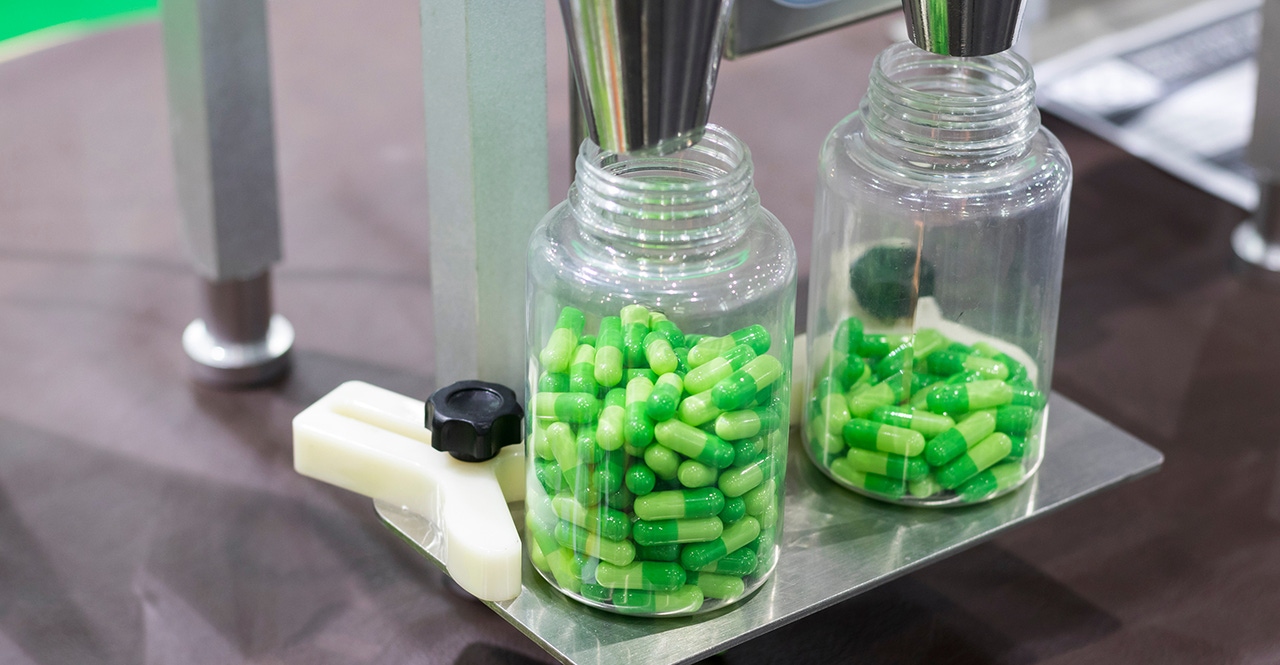The intricacies of overages for efficacy, compliance and safety
To meet regulatory and quality standards, manufacturers can—and, in most cases, should—intentionally add an overage of ingredients listed on the label.
July 25, 2019

FDA regulations require dietary supplements contain 100% of the ingredients listed on a product’s label throughout its entire shelf life.
On paper, the concept is easy enough to grasp, but it’s no easy feat to ensure the efficacious doses listed on product labels remain until expiration.
Starting on the day of manufacture, supplement products combat a host of environmental challenges that threaten stability of the product and its active ingredients. And even before a product is packaged and ready for release, manufacturing processes can introduce variances that can affect how much of an active ingredient ends up in the product, while testing methods can introduce variances that can affect how accurately those actives are measured.
To ensure supplements not only meet regulatory requirements, but also provide the efficacious dose promised to consumers, manufacturers can—and, in most cases, should—intentionally add overages, or surplus amounts, of ingredients listed on the label.
Determining the appropriate overage amount, however, is complex and requires consideration of many factors, including ingredient stability, dosage form, manufacturing processes, testing methods, the expiration date of the product and the intended target demographic of the product.
On the flip side, overages in excess can be considered adulteration by FDA, leaving manufacturers to face a difficult question: How much of an overage is enough without being too much?
Careful consideration must be paid by manufacturers to ensure overages are correctly implemented to create effective—and safe—products.
Overages are Important
Overages have an important job to do: They support product quality by ensuring supplement products provide the potency (and, thus, efficacy) indicated on the product’s label.
They also keep manufacturers out of trouble with regulators (assuming overages are implemented effectively to ensure supplements contain 100% of the ingredients on the label at the end of shelf life).
To be effective, overages must address the factors that can affect the amount of active ingredients in the finished product and how those actives are impacted by time and environmental factors.
“There’s a number of different issues that will affect the need for overages, and it’s different for different ingredients, different nutrients,” said Andrew Shao, Ph.D., interim senior vice president, scientific and regulatory affairs, Council for Responsible Nutrition (CRN). He advised manufacturers start with the basics: education.
“Certainly, a manufacturer needs to educate itself on the basics of what are things that affect the need for overage,” he said. These include: variability in the raw material; the manufacturing process and the variation in the manufacturing process; the analytical method variation that’s used to measure these ingredients; and stability of the ingredients.
Aaron Secrist, vice president, quality and regulatory affairs, NOW Foods, too, pointed to key factors that can affect the amount of active ingredients in a finished product and can be addressed via overage.
“The first one, and maybe the most obvious, is stability of the product,” he said. “You have to be sure for those anolytes that have a tendency to degrade over time … you have an overage in them, so as the product starts to degrade and lose some of that product that even at the end of the shelf life of that product you still have 100% of what you claimed on the level.”
Some ingredients are more susceptible to losing strength over time than others, he said, citing vitamin C as an example. “Vitamin C is something that’s going to have a tendency to break down relatively quickly, especially in a liquid environment—very, very quickly,” Secrist said. “You have to put in overages, sometimes really high overages in a liquid environment, to make sure you hit that 100% at the end of shelf life.”
Another reason to implement overages, Secrist said, is to accommodate variability related to the manufacturing process.
“Each manufacturing process has a degree of variability,” he explained. “If you’re making a capsule … [and] you say there’s supposed to be 300 mg in that capsule—if you set the target weight at 300 [mg], your encapsulation machine might bury plus or minus 10% of that, so you also typically will put in an overage for manufacturing variability.”
He advised, “The best way is certainly to set your target weight higher, so if you have a plus or minus 10% and you want 300 mg, then you would go up 10%. In that instance … set your target weight at 330 [mg]. That way if you fluctuate plus or minus 10 percent, you’re still going to be over the amount that you claim on that label.”
Secrist pointed to a third reason for adding overages: “There’s always some uncertainty in every analytical method.
“As you’re testing for that anolyte in the finished product, you want to be sure that you meet your specification. If your test result shows that you’re out of spec, and again because of that manufacturing variability and the testing invariability inherent in that method itself, you could see some fluctuation. You may really have 330 [mg], but depending on your method, it might only show 295 mg, which would be below your label claim of 300 mg.”
How Much is Enough?
Determining how much overage to add to a product is no easy feat. A range of considerations can affect how much overage is sufficient.
“Dosage form is certainly important,” Secrist said. “Is it a soft gel, is it a tablet, is it a capsule, a powder, a liquid? The active ingredients can degrade at different rates depending on surface area [and] exposure to oxygen, so that’s one of the things you have to take into consideration. Overages are going to be different in those different forms.”
Additionally, Shao noted the manufacturing process related to a particular delivery form can affect how much overage is needed.
He cited tableting as an example. “Tableting is an incredibly harsh process,” he said. “Lots of pressure is put on the ingredients and formulation that can cause things to degrade during the tableting process, so there may be encapsulation approaches that can be used for ingredients that protect them during the tableting process or, perhaps, avoiding tableting and going to something that is less harsh, like a capsule, for example, instead of a tablet.”
Certain ingredients can affect the stability of others. “Metals, for example, can lead to oxidation of other ingredients,” Shao said, “so keeping them separate can extend the shelf life and reduce the amount of overage that’s needed.”
Perhaps, Shao suggested, equally important to determining how much overage to add is taking measures to reduce the amount of overage needed. By addressing factors that can cause ingredient degradation, manufacturers may be able to reduce the amount of overage needed for a product.
This approach comes with a bonus: cost reduction.
“Approaches can be taken to try to minimize the amount of overage that’s needed because … adding more adds more cost,” Shao said. “Certainly, that’s something that manufacturers want to keep down is their cost.”
Packaging is key a factor to improve stability, and thereby reduce degradation of actives.
Certain packaging can protect ingredient from light and oxygen, which can degrade actives. Secrist implored manufacturers to consider “anything you can do to minimize the exposure to oxygen in the packaging.”
Another important consideration when determining overage amounts, Secrist said, is the target demographic.
“Who are you targeting?” he asked. “Are you targeting women? Are you targeting the elderly? Are you targeting children? Are you targeting specifically infants? There’s not a lot of data for infants and children.” He advised “trying to be conservative” when determining overage amounts for vulnerable populations.
“Trying to put more overage in that might be approaching potentially upper safe limits is not as good as potentially trying to lower the shelf life,” he said.
How Much is too Much?
According to Shao, “At some point, an overage can become an adulteration.”
Despite potential safety concerns, FDA has not established maximum amounts for dietary ingredients in supplements.
“The agency … does not set maximum levels, what we call regulatory maximums, for the amounts of nutrients, vitamins, minerals [or] other ingredients that can appear in a dietary supplement,” Shao explained, adding regulatory maximums are “different for different nutrients or ingredients. What determines [a maximum] is quite complex, so it makes it for difficult for the agency to draw a fine line.”
FDA’s concern, Shao suggested, is safety.
“I think If you were to ask the agency, they would default back to ‘It’s the responsibility of the manufacturer to ensure that their products are safe,’” he said. “If the overage that’s added for a given nutrient or collection of nutrients in the formulation or ingredients in the formulation result in the product being unsafe, then that’s a problem. But if it’s not—if it doesn’t result in safety issues—then really FDA is not going to be concerned.”
It's important to understand which ingredients pose a greater threat to safety when consumed in larger doses. Fat-soluble vitamins, for example, pose greater threat than water-soluble vitamins, which are excreted quickly when consumed in excess.
Manufacturers can turn to data on tolerable upper intake levels for various vitamins and minerals, established by the National Academy of Sciences and included as part of the dietary reference intakes (DRIs) nutrient recommendation by the National Institutes of Health (NIH), for guidance on safe amounts of certain nutrients.
“You have to know what the upper limits are and make sure that as you’re formulating you stay away from those upper limits,” Secrist said, “especially if you have products that are targeted specifically to the demographics with children, or pregnant or lactating women.”
Did it Work?
A critical piece of the overages pie is making sure the finished product does, in fact, maintain at least 100% of the active ingredients at the end of shelf life.
There’s only one way to be sure: testing.
Accelerated stability studies, which subject a finished product to harsh conditions to predict long-term shelf life, are a useful tool for manufacturers, but shouldn’t mark the extent of stability testing.
“The ability for accelerated studies to predict real time … can vary tremendously depending on what ingredients you have in your formula and then what dosage form you’re looking at,” Shao said. “What manufacturers should do is start out with accelerated, but ultimately [rely on] what they call ‘real time stability,’ which is just monitoring the stability of the ingredients under ambient conditions.”
Additionally, Secrist noted, products need to be tested at the time they’re released to ensure they contain the amount of overage determined necessary by stability studies.
He cited an example: a product claiming 1,000 mg of vitamin C on the label but needs 30% more ascorbic acid to achieve its two-year shelf life.
“If I know I need 30% more [ascorbic acid], then when I release that product, my release specification should be 1,300 mg of ascorbic acid, not 1,000 mg,” he explained. “I think that’s where a lot of companies fall down. They say, ‘My release specification is 1,000 mg.’ But if your stability shows you have to have 1,300 mg, 1,000 mg is not going to cut it. You’re not going to make it to the end of the shelf life.”
Ultimately, stability studies can help manufacturers understand the effects of time, temperature and oxygen on a product to help determine how much overage is needed. “Make sure that overage has been determined to be safe and then make sure it has that amount at time zero—at the time of manufacture—so that it’s going to make it through the shelf life,” Secrist said.
About the Author
You May Also Like

